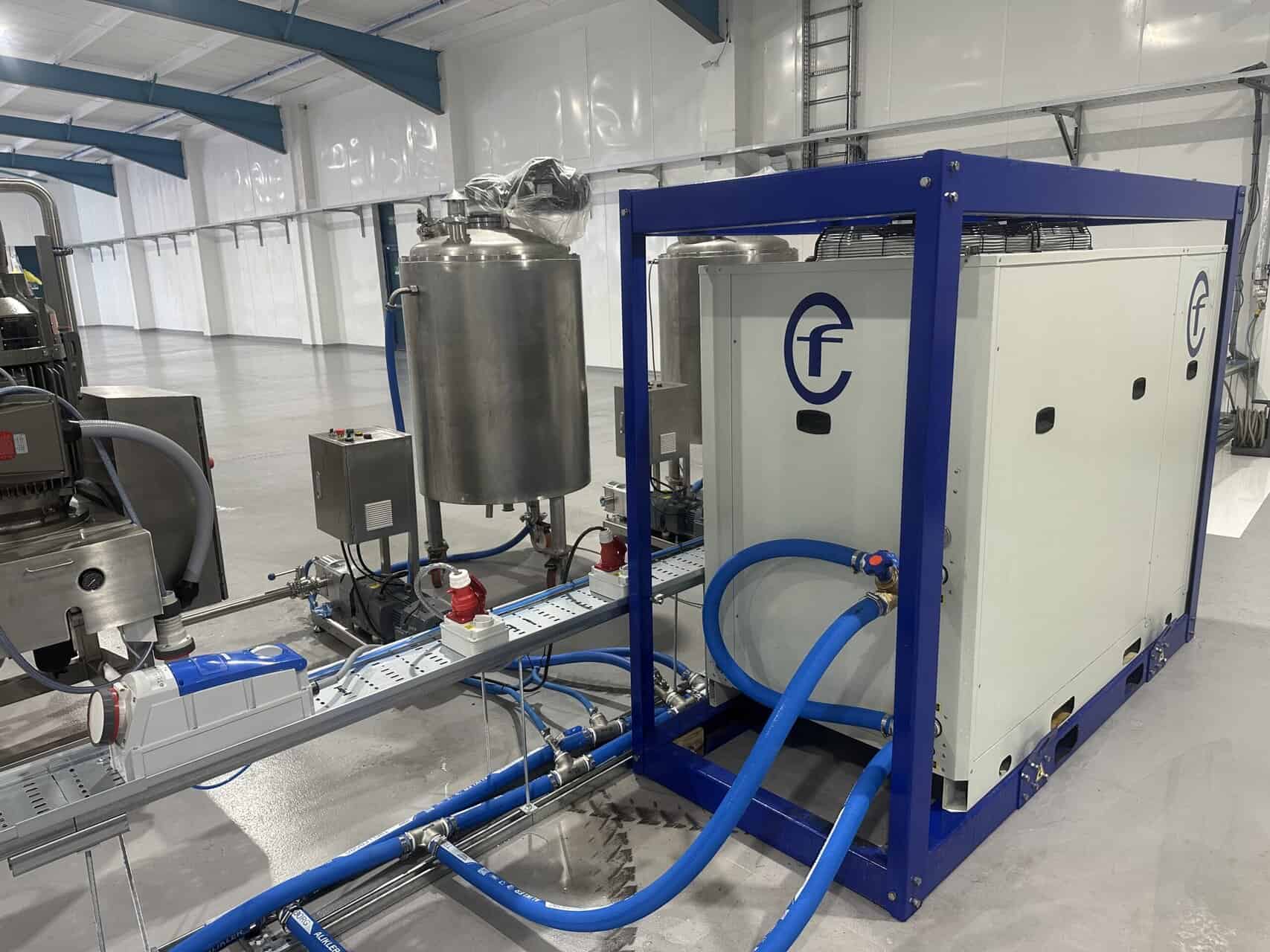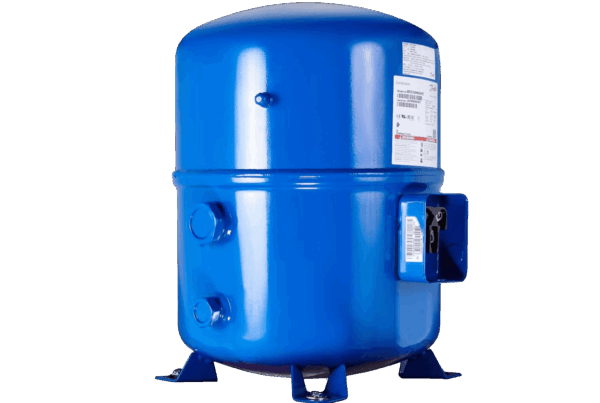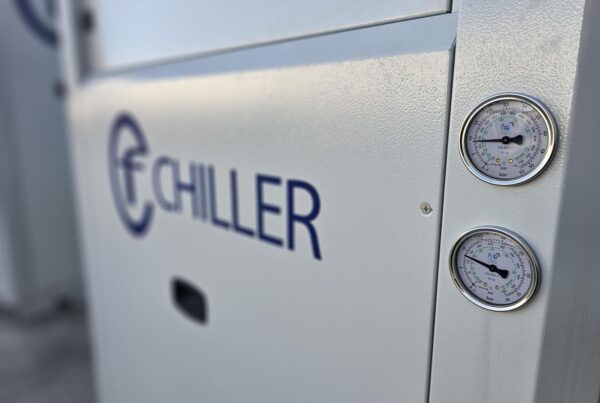When a production line grinds to a halt because process temperatures drift just a few degrees, every minute costs money.
If you are staring at a capex freeze or a tight Q4 window, temporary and low-capex water chiller packages can stabilise your process fast without committing to a full plant replacement.
This guide walks through practical options from portable air-cooled chillers to adiabatic free-cooling assistance, how to size and integrate them, the pros and cons you should weigh, and the quick wins that protect throughput before peak demand hits. It also shows where a permanent upgrade is justified and where a hired skid will do the job.
Air-cooled chillers – what they are and where they fit
An air-cooled chiller is a refrigeration machine that rejects heat to ambient air via condenser coils and fans. It chills water or glycol which then circulates to process loads such as mould tools, jacketed vessels, laser coolers, or heat exchangers.
In portable or skid-mounted form from 100 to 1,500 kW, these units deploy quickly, connect with flexible hoses, and run on standard UK industrial power.
Advantages of air-cooled chillers:
-
Fast to deploy, minimal site infrastructure, no cooling towers or water make-up required.
-
Lower installation risk, straightforward power and controls, simple hire logistics.
-
Good for temporary plants, seasonal peaks, shutdowns, and emergency cover.
Disadvantages of air-cooled chillers:
-
Lower peak efficiency than water-cooled systems, especially in hot weather.
-
Higher noise profile and larger footprint per kW.
-
More sensitive to fouling of condenser fins – needs clear airflow and regular cleaning.
Are air-cooled chillers better than water-cooled? It depends on your constraints. Water-cooled versions can be more efficient with towers or adiabatic assistance but bring water treatment, drift control, and extra plant complexity. For speed and simplicity, air-cooled often wins. For steady base-load efficiency and tight energy budgets, water-cooled or hybrid solutions can take the lead.
Do air-cooled chillers need water treatment? The closed process loop still benefits from filtration, biocide control, and corrosion inhibitors. If you run below 5°C, glycol protection and correct inhibitor chemistry are essential to avoid freezing and corrosion.
Industrial chillers and how they work
Industrial chillers are purpose-built systems that remove process heat through a vapour compression cycle. A commercial chiller compresses refrigerant, condenses it to reject heat, expands it to drop pressure and temperature, and evaporates it to absorb heat from the process water in the evaporator.
Controls range from simple thermostats to PLC and BMS integration with setpoint trims, staged compressors, and VSD pumps for part-load efficiency. Typical life expectancy is 12 to 20 years with good care – environment, load profile, and maintenance determine the upper bound.
Are chillers better than AC? For process loads, yes. Air conditioning is designed for occupant comfort and air handling, while a process chiller is built for continuous duty, tighter water temperature control, and integration with plate heat exchangers and process circuits.
What is the most efficient form of cooling? For UK industry, the best answer is usually a system approach – a high efficiency chiller with free cooling when ambient allows, adiabatic dry cooler assistance for shoulder months, VSD pumps and fans, and well-tuned controls. In winter, chillers can run in partial or full free-cooling mode, and yes, chillers are used in winter when processes need year-round control or sub-zero glycol.
Sizing a chiller with confidence
How do you size an industrial chiller? Start with the heat load in kW, not just a rule of thumb. Use:
Heat removed from the process:
kW = mass flow rate (kg/s) x specific heat (kJ/kg·K) x temperature drop (K).
Convert from tonnes: 1 refrigeration ton ≈ 3.517 kW.
Add diversity and safety factors for peak conditions but avoid oversizing that causes short cycling.
How to calculate the size of a chiller? Map maximum and typical loads, duty cycle, inlet and outlet water temperatures, ambient design points, and allow for hydraulic losses. For a mixed site, segregate loads by temperature and stability requirements.
If you need 400 tons, that is roughly 1,406 kW.
How much does a 400 ton air-cooled chiller cost? Market pricing varies by spec and brand; as a broad guide in the UK, a new 400 ton air-cooled unit may run into the high six figures, with installation and electrical works on top.
How much to install a chiller? Site specifics drive cost, including plinths, cranage, cable runs, breakers, hoses, buffer tanks, and controls integration. A rapid site survey is the only reliable way to quote.
Temporary chiller options that protect uptime
Portable and skid-mounted air-cooled chillers, 100 to 1,500 kW:
-
Speed – often on site within days, connected in hours for straightforward circuits.
-
Power – 400 V, 3-phase supply; plan for cable runs, distribution boards, MCBs or MCCBs, and RCD protection where required.
-
Hydraulics – flexible hoses, quick couplings, temporary headers, buffer tanks to smooth flow, inline strainers, and duty or duty/standby pumps. Include a by-pass for maintenance.
Packaged AHUs or coils for spot process loads:
Ideal for high-heat zones or localised equipment. Couple a coil or AHU to the hired chiller loop to pull heat from air or a small glycol coil on the machine.
Glycol circuits for sub-zero:
What does glycol do in a chiller? It depresses the freezing point and provides corrosion protection. Select the right glycol type and inhibitor package for food-grade or industrial duty, and target the correct percentage for your minimum leaving-water temperature.
Adiabatic dry coolers for free-cooling assistance:
What is free cooling in a chiller? When ambient air is cool enough, a dry or adiabatic cooler rejects heat directly, reducing or bypassing compressor work. Night free-cooling in Q4 can deliver large savings and added resilience.
Temporary chiller plus plate heat exchanger bridges:
Use a plate heat exchanger to isolate an existing line that cannot be contaminated or disturbed. This is a clean way to add capacity without opening the main circuit.
Control integration:
From simple thermostats holding a water setpoint, to PLC or BMS commands for load staging and alarms. Stage capacity and pair with VSD pumps for stable flow at part load.
Water treatment and F-Gas compliance:
Treat the temporary loop with biocide, filtration, and glycol dosing as needed. Keep documented refrigerant leak checks and use certified personnel for handling. UK F-Gas rules apply to hired plant exactly as they do to owned equipment.
Deployment, safety, and maintenance best practice in the UK
Process safety: Risk assess siting, airflow, access, and noise. Protect hoses and cables from traffic and trip points. Fit drip trays and bunds where needed.
Leak checks: Refrigerant leak testing, plus routine hose and joint inspections.
Water quality: Test hardness, pH, inhibitor concentration, and microbiological load. Maintain strainer hygiene and flush debris from new or temporary pipework.
Planned preventative maintenance: Schedule filter cleans, condenser coil washing, oil and refrigerant health checks, sensor calibration, valve and VSD verification. A solid PPM plan cuts downtime and keeps efficiency steady.
What is the main problem with chillers? Poor maintenance and incorrect setup. Most unscheduled outages trace back to fouled heat exchangers, low flow, control misconfiguration, or refrigerant issues. A simple design review and regular care avoids the majority of failures.
Quick wins for Q4 peak
-
Night free-cooling via adiabatic or dry coolers – maximise compressor off time when ambient drops.
-
Setpoint optimisation – lift leaving-water temperature by 1 to 2 K where process allows to improve COP.
-
Heat load segregation – split high delta-T or intermittent loads onto a dedicated loop.
-
Insulate hot legs and exposed pipework to reduce heat gain.
-
Valve balancing and proper by-pass settings to stabilise flows.
-
Staged capacity control with VSD pumps and, where supported, fan VSDs.
When to upgrade permanently versus hire
Choose a permanent plant upgrade when you have steady year-round base load, clear efficiency targets, and space or water infrastructure to support long-term optimisation. Choose temporary or hired chillers for seasonal peaks, capex deferral, planned shutdowns, line moves, trials and pilots, or when a failure threatens product quality and you need capacity now.
Many sites land on a hybrid model – a right-sized efficient base plant supported by hired modules during peaks.
How Evolution Cooling helps
You get rapid site surveys, temporary plant design and hire across air-cooled and adiabatic units, packaged AHUs and coils, and 100 to 1,500 kW chillers.
We handle installation and commissioning, compliant refrigerant handling by certified F-Gas engineers, water treatment and glycol dosing, and PPM programmes with 24/7 emergency support.
If you need to bridge an isolated line with a plate heat exchanger, build a sub-zero glycol loop, or add free-cooling capacity, we will design and deliver it quickly.
For an immediate conversation about stabilising your process, request a rapid process cooling assessment and a temporary chiller plan to protect yield and uptime.
Useful extras and FAQs at a glance
What are the three types of chillers? Air-cooled, water-cooled, and absorption. For industrial hire in the UK, air-cooled dominates due to speed and simplicity.
Can air-cooled chillers be inside? Usually sited outdoors for airflow and heat rejection. Indoor use requires ducted discharge and generous ventilation which is seldom practical for hire units.
How does a commercial chiller work? Through the vapour compression cycle with controlled refrigerant flow, heat exchange at the evaporator and condenser, and staged or variable compressors.
How long do industrial chillers last? Typically 12 to 20 years with good maintenance and clean operating conditions.
Summary
Temporary water chillers and supporting equipment give you a fast, cost-effective route to stable process temperatures.
Air-cooled units from 100 to 1,500 kW deploy quickly, adiabatic dry coolers unlock night free-cooling, plate heat exchangers isolate sensitive circuits, and glycol loops push safely below zero.
Get the fundamentals right – correct sizing, clean hydraulics, solid controls, water treatment, and F-Gas compliance – and you will protect throughput without heavy capex.
For expert support on specification, rapid deployment, and ongoing care, speak to Evolution Cooling for a rapid assessment and a temporary chiller plan.
Relevant resources:
-
Learn more about temporary options with temporary chiller hire.
-
Explore low temperature options with glycol chiller.
-
Understand fundamentals in our chiller system guide.
📞 Call: 0121 820 8946
📧 Email: [email protected]
🌐 Visit: www.evolution-cooling.com





